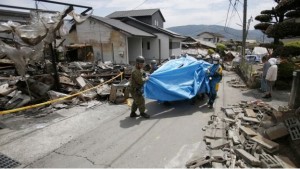Losses from the recent earthquakes which struck the Kumamoto area of Kyushu, Japan, are expected to be “manageable” for non-life insurers in the country, due to their robust capitalisation and conservative reinsurance arrangements.
 The rating agency said in a briefing that it expects rated non-life insurers in Japan, that are affected by the recent earthquakes, will be able to withstand the losses, with a moderate impact to their earnings but little effect on financial strength due to strong capital levels.
The rating agency said in a briefing that it expects rated non-life insurers in Japan, that are affected by the recent earthquakes, will be able to withstand the losses, with a moderate impact to their earnings but little effect on financial strength due to strong capital levels.
While the earthquakes are expected to lead to sizeable losses, AIR Worldwide estimated an insurance and reinsurance industry loss of up to $2.9 billion, the impact could be mostly mitigated by the release of catastrophe reserves, A.M. Best explains.
A.M. Best notes the low levels of earthquake insurance penetration, the fact that the Japanese government retains a lot of residential earthquake risk and that business interruption is a big known in identifying the final industry loss from this event.
But, despite uncertainty in how high the losses could be, the rating agency feels that Japanese insurers are equipped to withstand an earthquake of this magnitude and impact.
Also of note, the rating agency says that “Japanese domestic non-life insurance companies have strengthened their catastrophe risk management over the past five years,” in the wake of events such as the Thailand flooding and Tohoku earthquake.
That suggests increased use of reinsurance, which A.M. Best notes are typically conservative, with Japanese insurers often using more reinsurance and retaining less risk than many western primary insurance companies.
Japanese insurers conservative reinsurance arrangements could result in more of the losses being dealt with by reinsurance and ILS markets, particularly as commercial earthquake risks are more often found to be in the private insurance market, and thus more likely to be reinsured.
A.M. Best estimates that as much as 20% of the economic loss from the Kumamoto earthquakes may be insured.
It remains very difficult to estimate the impact to insurance, reinsurance and indeed insurance-linked securities (ILS) markets, funds and sidecars. The fact that Japanese insurers maintain conservative reinsurance arrangements and prudent catastrophe risk management, suggests that there will be an impact across reinsurance capital structures which attach to losses at the level this event suggests.
So that means catastrophe bonds are certainly safe, but reinsurance sidecars and ILS funds investing in private transactions and collateralised reinsurance will likely see at least some attritional level of impact to net asset values as a result of these quakes.
On Japanese earthquake insurance penetration, A.M. Best explains:
Property exposures are underwritten through separate earthquake risk coverage in Japan. Currently, earthquake insurance, as a rider, is attached to the main contract of re insurance for both corporate and household coverages. Commercial earthquake risks are covered by both primary non-life and reinsurers from both the domestic and overseas markets. On the other hand, residential earthquake risks are borne primarily by the government, which reinsures a significant portion of the earthquake insurance liabilities underwritten by the private insurance companies in Japan. This scheme is operated for households based on “no pro t, no loss” given the nature of earthquake risk and the potential impact on Japanese citizens.
Although Japan is prone to earthquake risk, the penetration of commercial earthquake insurance remains relatively low. In the last event, the major non-life insurance groups covered around one-fourth of total losses incurred in the corporate sector. While corporate earthquake risk coverage is getting increasingly important, the percentage of the corporate sector with coverage appears to remain low, at a similar level as 2011 partly due to the non-life insurers’ tighter control of underwriting acceptances. Also, the penetration of the residential earthquake insurance (number of earthquake insurance policies to number of households) has increased only moderately to 28.8% in 2014. The penetration of residential earthquake risk stood at around at 23.7% in 2010 according to the General Insurance Association of Japan. The penetration in the recently impacted Kumamoto Prefecture was 28.5% in 2014, in line with the countrywide average.
Also read:
– Economic losses from Japan earthquake up to $3.5 billion: RMS.
– Japan earthquake insured losses up to $2.9 billion: AIR.
– Japan, Ecuador quakes to impact Q2 reinsurance earnings.
– Stronger M7+ earthquake extends damage in Kumamoto, Japan.
– Strong 6.4 earthquake strikes Kumamoto, Kyushu, Japan.
 View all of our Artemis Live video interviews and subscribe to our podcast.
View all of our Artemis Live video interviews and subscribe to our podcast.
All of our Artemis Live insurance-linked securities (ILS), catastrophe bonds and reinsurance video content and video interviews can be accessed online.
Our Artemis Live podcast can be subscribed to using the typical podcast services providers, including Apple, Google, Spotify and more.































